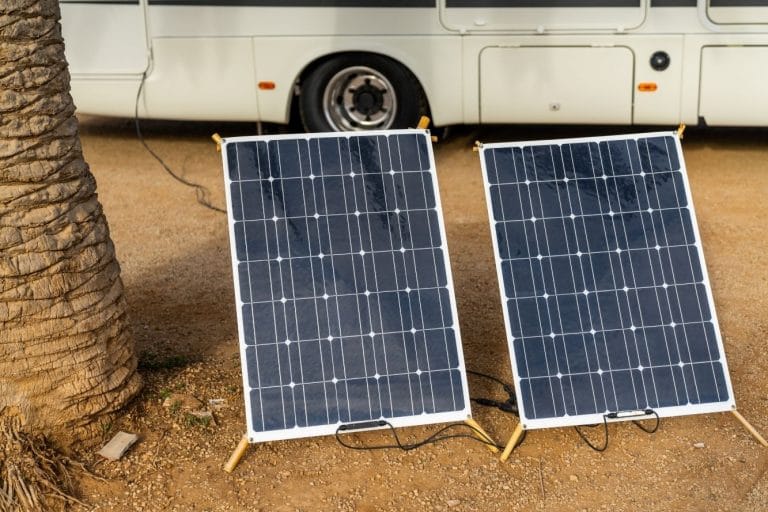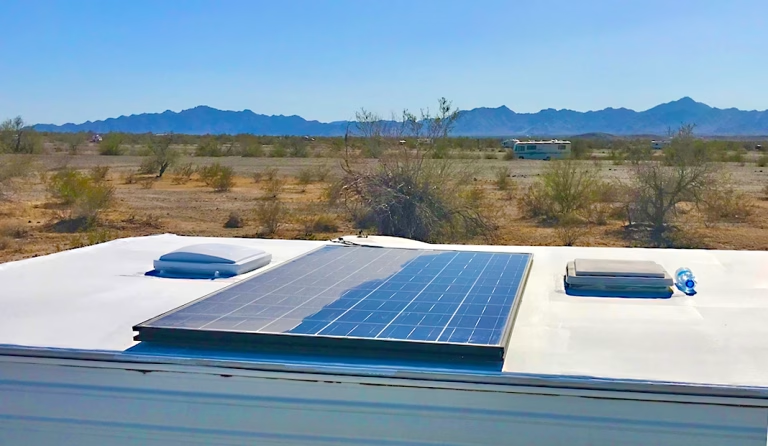RV Solar Installation Cost: What You’ll Pay for a Basic RV Solar Power System
This post may contain affiliate links.
Curious about RV solar installation cost? Whether you’re ready to ditch the generator or just want more off-grid flexibility, installing a solar setup can be a smart long-term investment. But before you buy your first panel, it’s important to understand what’s involved—and how much it will cost for an RV solar system.
New to RV solar? Be sure to read my Beginner’s Guide to RV Solar Power Systems first, where I break down how RV solar works, how to calculate your power needs, and how to design a system that fits your rig and lifestyle.
This article focuses specifically on estimating the cost of adding solar to RV setups, using a simple 400-watt solar setup as an example.
What Does an RV Solar Installation Cost?
You can expect to spend between $975–$2,150 for components in a 400-watt RV solar system. If you hire a professional installer, labor could add another $500–$1,500, depending on the complexity.
If you’re aiming for a system that can power an air conditioner for a few hours a day and run a washing machine a couple of times a week, expect to spend $5,000 to $10,000 or more. Systems that size require significantly more wattage (usually 1,200–2,000 watts or more), a larger inverter, and a substantial lithium battery bank.
Here’s a detailed look at what you’ll need to include in your budget.
Essential Components of an RV Solar System
1. Solar Panels for RV Cost
Estimated Cost: $150–$450 each
Budget for the type of solar panel you choose, multiplied by how many you’ll need (learn how to calculate your solar needs here). For a 400-watt array, there are two schools of thought: Either get as few panels as you can to save space, or have at least two panels so that if one goes out, you still have 200 watts to work with until you can replace it.
One 400-watt flexible panel—which is recommended for a beginner’s system—currently runs between $150–$450 depending on quality. Generally, you get what you pay for. I’m a bargain shopper, so I try to stay in the middle of the range. I don’t need brand name, but I do pay close attention to the reviews. No reviews, no sale—this is too important a purchase.
Trusted brands: Renogy, BougeRV, Rich Solar

2. Charge Controller
Estimated Cost: $250–$550 (can range from $50–$2,000)
This can run anywhere from $50 for a basic PWM to nearly $2,000 for a sophisticated digital MPPT model.
There are two main types:
- PWM (Pulse Width Modulation): More basic and cost-effective
- MPPT (Maximum Power Point Tracking): More efficient and suited for larger systems, especially when you want to maximize output
I paid about $250–$400 for my first few, and had enough issues with them that I bit the bullet and paid $550 for a programmable, digital MPPT model for the 750W system in my last rig. I will never opt for the cheaper ones again, because I never had a single hour of trouble from that last one.
Trusted brands: Renogy, Victron, Blue Sky

3. Power Inverter
Estimated Cost: $150–$300 for 2,000–3,000W
You’ll want to choose an inverter that can accommodate the highest starting draw you anticipate. If you size it based on running draw, you’ll blow fuses constantly and just be frustrated.
My first couple systems used 2,000-watt inverters. They were likely overkill, but I rarely blew a fuse unless there was a larger issue. Make sure you get one that has an emergency alarm on it. Better the annoyance of being woken out of a sound sleep to check it out than to die in your sleep in a fire.
Also, if you use computers or smart TVs, spring for the pure sine wave model. It adds about $50 but can save you a lot of headaches when devices act up.
Trusted Brands: Renogy, Victron, Bestek
4. Safety Devices
Estimated Cost: ~$50
These components are non-negotiable. Your system should include, at minimum:
- Inline 20A fuses between solar panels and charge controller
- A cutoff switch you can easily access to shut down the system in an emergency
- Inline mega fuses between the charge controller and the battery bank
- Inline fuses between the battery and any directly connected 12V devices
These should NOT be optional. The right safety devices can save your solar system, your RV, and even your life.
Brands to consider: Victron, Littelfuse
5. Cables and Wiring
Estimated Cost: $100+
Depending on how long your cable runs need to be, expect around $50 for cables from panels to the charge controller (using 10 AWG wire), another $50 for wiring from controller to battery and from battery to inverter, and additional wiring for any 12V devices.
Tips:
- Keep your runs as short as possible to avoid power loss from friction.
- Use 10 AWG, THHN, or USE-2 stranded wire—it’s more flexible and therefore ideal for mobile systems.
- Estimate ~$50 for panel-to-controller wiring and another ~$50+ for controller-to-battery and battery-to-inverter

6. Batteries
Estimated Cost:
- $260–$400+ for 2 x 100Ah AGM
- $130–$800+ for 1–2 LiFePO4 (lithium)
No matter how much solar power you generate, you can only use as much as your batteries can store.
For a 400W solar system, two 12V 100Ah batteries will give a good balance of capacity and portability. If you need more power, especially for boondocking, a pair of 200Ah batteries may be a better fit—but they’re heavier and more expensive.
If you choose the latter, try hard to go with LiFePO4 (lithium) batteries. They’ll put far less weight on your rig and strain on your back. If cost is an issue, get just one to start with and add another as you can afford it.
Popular options:
- AGM: Renogy, Optima, Interstate
- Lithium: Battle Born, BigBattery.com, Renogy
7. Battery Usage Monitor (Optional)
Estimated Cost: $30–$120
These small digital readouts monitor performance to eliminate guesswork about usage and improve battery bank performance and longevity. These are nice to have, but not essential.
Suggested brands: Renogy, Victron, Redodo
8. Battery Health/Capacity Monitor (Optional)
Estimated Cost: $35–$80
This type of monitor doesn’t just show your battery’s charge level—it also tells you how long it’s been since it was fully topped off. That info helps reduce battery stress and prolongs life.
It’s not necessary, but I’ve always had a Midnite unit and would now feel vulnerable without one.
Trusted picks: MidNite MNBCM, Powerwerx, Multipure
RV Solar Installation Cost
If you don’t want to DIY your RV solar installation, you’ll need to factor labor into the cost of RV solar system setup. Labor costs will vary widely depending on your location and who is available to do the work, but budgeting up to $1,500 for RV solar panel installation cost is a good starting point.
Cost of RV Solar System: Summary
| Component | Cost Range |
|---|---|
| Solar Panels | $150–$450 |
| Charge Controller | $250–$550 |
| Power Inverter | $150–$300 |
| Safety Devices | $50 |
| Cables & Wiring | $100+ |
| Batteries (AGM or Lithium) | $260–$800+ |
| Optional Monitors | $30–$120 each |
| Total (Parts Only) | $975–$2,150 |
| Installation Labor | Up to $1,500 |
Is the cost of adding solar to your RV worth it?
While the cost of an RV solar system can seem high upfront, many RVers find the benefits far outweigh the expense. You’ll be able to camp wherever you like without hookups, avoid the noise and fumes of a generator, and reduce long-term fuel and campground costs.
Plus, with so many plug-and-play kits and DIY resources available, you can start small and expand your system over time.
For tips on installing your RV solar system, read this article: Solar Power for RV Tips: Real World Advice from an Experienced RVer





